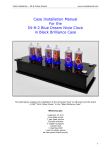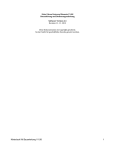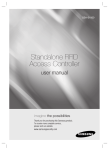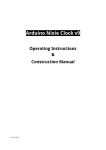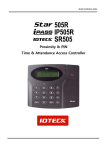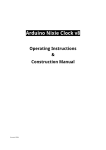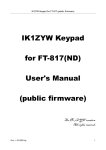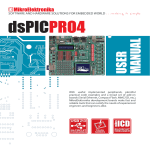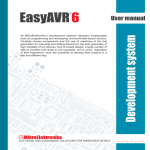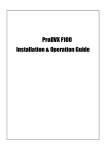Download Assembling instructions and user manual
Transcript
Temp’n’Glow IN‐16 Nixie Thermometer Documentation "Temp'n'Glow", the new secret among nixie enthusiasts, is a Nixie tube thermometer for the slim, beautiful IN‐16 tubes. Fast, secure installation without any adjustment are the features of this kit as well as its modern look. But the technology is state of the art, too. A smart menu system makes operation easy. Adjustable change interval, error detection and many other features are standard on "Temp'n'Glow". A highlight is the so‐called "Cathode Poisoning Prevention". This feature allows the digits to go through certain periods (slot‐machine effect). This will protect the cathode deposits and as a result of that your tubes live longer. Enjoy your "Temp'n'Glow" Nixie tube thermometer! This document is copyrighted. No parts of this documentation may be used commercially. 1 Temp’n’Glow IN‐16 Nixie Thermometer Documentation Table of contents 1 Safety and Legal Warnings .....................................................................................................3 2 Features ........................................................................................................................................4 3 Functions ......................................................................................................................................4 4 Settings ..........................................................................................................................................5 5 Display limits ..............................................................................................................................6 6 Error indication..........................................................................................................................6 7 Special Notes on the IN16 tubes..........................................................................................6 8 Part List .........................................................................................................................................8 9 Soldering.......................................................................................................................................9 10 Mounting of the Neon glow lamp.................................................................................... 10 11 Solder the tubes.................................................................................................................... 11 12 Solder the Leds...................................................................................................................... 12 13 Switching off the underside LED illumination ........................................................... 13 14 Mounting the temperature sensors............................................................................... 14 15 Maximum length of sensor cables.................................................................................. 14 16 Connecting the thermometer to power........................................................................ 14 17 Specifications......................................................................................................................... 15 2 Temp’n’Glow IN‐16 Nixie Thermometer Documentation 1 Safety and Legal Warnings DANGER: This circuit design includes a switching‐mode voltage converter which generates 170 VDC. Therefore, assembly should be attempted only by competent qualified personnel experienced in electronics assembly and high voltage safety. Safe assembly and operation of this kit is completely the reader’s responsibility. Read instructions: All the safety and operating instructions should be read carefully and completely before the thermometer is operated. Heed warnings: All warnings on the appliance and in the operating instructions should be adhered to. Retain Instructions: The safety and operating instructions should be retained for future reference. • If one of the tubes is broken or damaged, immediately pull the power plug out of the thermometer and contact the customer support. • The tubes are made of glass and are consequently very easy to break. Because of their fragility, it is important that you keep the thermometer in a safe place free from the possibility of being struck inadvertently. • No part of the thermometer may be swallowed or inserted into body openings. • The power supply may not be swallowed or inserted into body openings. • No part of the thermometer or the power supply may be used for other purpose other than described in this user manual. • Water and moisture: The thermometer should be kept in a dry room free from humidity and dust. The thermometer should not be used near water – for example, near a bath tub, washbowl, kitchen sink, laundry tub, in a wet basement, near a swimming pool, in a sauna, etc. In addition the thermometer should be kept out of direct sunlight and high temperatures. • Object and liquid entry: Care should be taken so that the thermometer does not fall into liquids or have them spilled over the thermometer. • Do not use this appliance for anything other than the intended use as described in the manual. • Immediately pull the power plug out of the thermometer and contact the customer support if the appliance does not appear to operate normally or exhibits a marked change in performance. In this case do not run the thermometer again! • This thermometer is not a toy! Keep this thermometer out of the reach of children. • Pay attention that this thermometer shall only be touched by people who have completely read and understood the user manual. IMPORTANT: Please follow the assembly steps with extreme care. Please operate the thermometer only in an enclosed housing which prevents contact with the dangerous voltages present on both printed circuit boards (PCB). DISCLAIMER: The information in this document is provided strictly 'as is'. It is hereby stated that this kit is to be assembled only by experienced electronics engineers. No troubleshooting information is provided. Readers should not attempt to build this kit and/or design unless they are competent at electronics assembly and understand the dangers of mains voltages. Further, www.nixieclocks.de takes no responsibility for any possible personal or property damage. No responsibility is accepted for any damage, injury (however serious) or death. In no event shall www.nixieclocks.de be held liable to you or any third parties for any special, punitive, incidental, indirect, consequential, or any other damages resulting from the assembly or use of this kit and/or design. The assembled unit should be properly encased to prevent contact with high voltages. All applicable UL, CCE, VDE and local regulations must be considered. Commercial use of the kit, circuit designs, software or any parts thereof requires express written permission. 3 Temp’n’Glow IN‐16 Nixie Thermometer Documentation 2 Features ‐ Input voltage from 10 ‐ 14 Volt DC ‐ Low current consumption is 150 mA ‐ Standard power adapter for worldwide use available ‐ very high efficiency by using modern switching power supply technology ‐ switchable floor lighting ‐ pcb illumination by LED light (can be switched off) ‐ easy to build ‐ no smd parts ‐ sophisticated software with user menu ‐ Cross fading selectable in 5 different levels or to be switched off ‐ Cathode poisoning prevention ‐ Up to 2 temperature sensors connectable ‐ "minus sign tube" ‐ "minus sign tube" can also be replaced by left decimal dot ‐ Error detection for faulty temperature sensor or faulty signal ‐ small, compact circuit board ‐ Simple 2‐button operation ‐ including mounting spacers ‐ alternating cycle between inside and outside temperature selectable ‐ All settings are stored in case of power failure ‐ no adjustment necessary ‐ measuring range from ‐55°C to +85°C / ‐67°F to +99°F ‐ Display in ° C or ° F ‐ Long cables available for external sensor up to 10 m ‐ Pre‐assembled temperature sensor cable available from web shop 3 Functions Preliminary hint: Temperature sensor 1 = inside temperature Temperature sensor 2 = outside temperature Left decimal dot of the left tube: Has no function if the minus sign neon lamp and R42 are installed. Shows a negative sign of the temperature if no minus‐neon lamp is installed but R42 is installed. Right decimal dot of the left tube: No function Left decimal dot of the right tube: No function Right decimal dot of the right tube: It shows whether the inside or the outside temperature is displayed. It lights up when the outside temperature is displayed. It is not lit when the indoor temperature is displayed. Display: The two tubes permanently show the temperature in ° C or ° F, depending on which unit in the menu is set. The display is two digits – no display of ½ a degree. At negative temperature, the minus sign (neon lamp or left of the decimal dot of left tube) is on. 4 Temp’n’Glow IN‐16 Nixie Thermometer Documentation The inside and outside temperatures (or vice versa) are shown in the interval that is set in the menu (change interval) Menu / Settings: "Menu" button in the user menu is as follows (circle menu): Temperature Display>> Change interval>> cross fading value>> number of probes>> unit>> CP Prevention After "CP Prevention is shown the menu goes back to Temperature display if you press the Menu button again. The menu is shown by the left tube as follows: 1 = change interval 2 = Cross Fading value 3 = number of probes 4 = Unit 5 = CP Prevention While you are in the menu the following settings are: ‐ Cross fading and CP Prevention are generally deactivated. ‐ The decimal dot of the right tube flashes with an interval of 0.25 seconds ‐ The minus sign resp. the left decimal dot of the left tube is turned off. After selecting the menu item, the "Set" button is used to change the values. This value is indicated in the right tube. Each press of the button "Set " increments the value by one step. After having reached the highest value, the value series will start again from the beginning. Subsequently, all settings are described. 4 Settings „1“ = change interval The display shows "1x" whereby the value of x is the range 1‐9 (in seconds). Value x= The temperature (inside / outside / or only one of them) is updated at a range of 1‐9 seconds. Factory setting = 2 seconds. „2“ = Cross Fading value The display shows "2x" whereby the value x has the range from 0‐5. The values of x have the following meanings: 0 = Cross Fading is off 1 = very fast cross fading 2 = Cross Fading fast 3 = Cross fading fast (factory setting) 4 = slow cross fading 5 = very slow cross fading The cross‐fading affects all digits of the tubes, the minus sign (or the left decimal dot of the left tube) and the right decimal dot of the right tube. The Cross Fading is generally not active when scrolling through during the CP Protection, or while you are in the menu and while an error is displayed by the left decimal dot. „3“ = Number of sensors The display shows "3x", whereby the value x has the range from 1‐2. The values of x have the following meanings: 1 = one temperature sensor is connected to socket 1 or soldered on the pcb 2 = one temperature sensor is connected to a socket or soldered on the pcb and a second temperature sensor is also connected to socket 2 or soldered on the pcb (the usual way for outdoor temperature measurement) ‐ (factory setting) 5 Temp’n’Glow IN‐16 Nixie Thermometer Documentation 4 = Units The display shows "4x", whereby the value x has the range from 1‐2. The values of x have the following meanings: 1 = The tubes show the temperature in the unit ° C (factory setting) 2 = The tubes show the temperature in the unit ° F 5 = CP Prevention The display shows "5x" whereby the value x has the range from 0‐1. The values of x have the following meanings: 0 = Prevention is off 1 = CP Prevention is on (factory setting) If CP prevention is switched on, the Cathode Poisoning Prevention is executed every 5 minutes. This is done as follows: The minus sign or the left decimal dot of the left tube and the right decimal dot of the right tube is switched on. The digits 0‐9 are scrolled through both tubes. Duration of the scroll operation: 4 seconds After having done that the display will show the temperatures again. 5 Display limits If the (theoretical) temperature is below ‐99 or over +99 ° C or ° F the display still shows ‐99 to +99. 6 Error indication If one of the sensor is not connected or produces a bad signal, then "99" is displayed and the minus sign or the left decimal point blinks left in the rhythm of 0.25 seconds (no cross‐fading). The right decimal point of the right tube remains unchanged in its function. 7 Special Notes on the IN-16 tubes There are several variants of the IN‐16 tubes. One has a hole with Ø 4 mm in the spacer, the other has not. Here you can see this difference: With hole: without hole If you fit any under body lighting tubes, this difference is not important to you. However, if you install an under body lighting, you have to refer to the following. If you use the version with a hole in the spacer, there is no need to change anything, because the LED exactly fits into this hole. But if you use the version without the hole, then you have to drill a hole of Ø4, 5 mm into the middle of the spacer. To do so, slide away the spacer from the tube and drill the hole. Note: From Nocrotec you get matched tube sets WITH hole in spacer for the LEDs (HERE) 6 Temp’n’Glow IN‐16 Nixie Thermometer Documentation A little hint to mount the tubes: After you have drilled, you need to connect the tube wires through the holes in the spacer. This can easily be done by a „spiral staircase cut“ of the wires. Then the threading into the spacer and the board will be much easier. Pinout IN‐16 seen from top Step cut of wires 7 Temp’n’Glow IN‐16 Nixie Thermometer Documentation 8 Part List Part No Pieces Description BRD1 1 pcb ASP 2 Adhesive pads C01 1 Capacitor 1 nF C10-C16 7 Capacitor 100 nF C31 1 Electrolytic-Capacitor 4.7µF, U=250V C23 1 Capacitor-Capacitor 220µF/25V CR1 1 Resonator, 3-pin, 4MHz D1 1 Diode UF4004 D2 1 Diode, 1N4004 H1-H4 10 Screw M3x6mm H1-H4 4 Distance holder M3 15 mm IC5 2 Bolt, M3 IC1-2 2 74141 or similar IC3 1 ATtiny461-20PU IC3 1 IC-socket 20 pin IC4 1 MC34063A IC5 1 Regulator, 5Volt, 1A, 7805 IC6 1 DS18S20 Temperature sensor with cable (1 meter) L1 1 Coil 330 µH / 1,4 A R10-R11 2 Resistor, 180 Ohm R20 1 Resistor, 390 Ohm R30-R31 2 Resistor, 2,2k R32-R33 2 Resistor, 4,7k R38 1 Resistor, 8,2k R40-R43 4 Resistor, 16k - R42 resistor not needed if you do not use left decimal point in left tube R50-R51 2 Resistor, 68k R60 1 Resistor, 180k R70 1 Resistor, 1,1M S1-S2 2 Push button 3.5x8, 35mm T1-T2 2 Transistor MPSA42 T3 1 FET IRF630, mounted on pcb X1-X2 2 Connector for temperature sensors, angled, 2,54mm, 3 pin JP1 1 Jumper Header, 2 pin, angled JP1 1 Jumper black, 2,54 mm X3 1 Socket for power supply plug (5,5mm / 2,5 mm) You get a complete set of 2 IN-16 tubes with hole in spacer, 2 LEDs and the Minus Glow Lamp from www.nocrotec.com 8 Temp’n’Glow IN‐16 Nixie Thermometer Documentation 9 Soldering Attention: If you have purchased the acrylic case for the thermometer, please read that documentation first! First solder all the flat components such as resistors and diodes. Resistor R42: This is only used if no glow lamp (GL1), but the left decimal point of the left tube is used as a negative indicator. If you use the GL1 glow lamp, R42 is not mounted. Then solder the ICs. IC3 is socketed, so solder the socket here first. When soldering the ICs please watch out for the marking that you find on the IC and on the pcb. Then L1, the capacitors, the resonator CR1 and the coil are soldered in. The resonator has no polarity. Figure 1 resistor and diodes mounted Figure 2 jumper pins, capacitors mounted Now solder the transistors T1, T2, T3 and IC5. T3 and IC5 have a heat sink. The components are installed horizontally and are secured with M3 x 6 screws and M3 nuts onto the board. This is to cool the components. Then the connections for the temperature sensors, the push buttons and the power supply connector are soldered. When you solder the power supply connector make sure that it is flush to the back of the pcb. This is important, if you consider to use our acrylic housing. 9 Temp’n’Glow IN‐16 Nixie Thermometer Documentation Figure 3 pcb nearly ready Now turn the circuit board and solder the holder for the glow lamp, if you wish. You can mount the neon glow lamp without the holder. The wires of the neon glow lamp should be isolated with shrinking tube to prevent a short circuit. 10 Mounting of the Neon glow lamp ‐ Cut fuse holder tab ‐ Cut the fuse holder contacts ‐ Stretch silver wire (diameter 1mm) ‐ Solder wire from the rear ‐ Bend the wires ‐ Pull 2 pieces of shrinking tube (21 mm) over the glow lamp wires and shrink ‐ Pull a piece of shrinking tube (18 mm) over the wire of the holder and shrink ‐ Blacken the front tabs of the holder with a black permanent marker to prevent a mirror effect. ‐ Solder holder into the board (distance is set by shrinking tube) Building the glow lamp holder 10 Temp’n’Glow IN‐16 Nixie Thermometer Documentation 11 Solder the tubes Next, the tubes are soldered. The tube is now getting a "step cut" so the wires can be put into the holes on the pcb more easily. To be sure that the tube is soldered correctly into the board it is important to know where the anode is. Figure 4 The "step cut" The anode is marked white and you find it at the back of the tube. You can see this easily in the picture below. Figure 5 Anode marked white – tube layout IN‐16 The longest wire after the “step cut” should be the anode wire. See where this wire goes: Figure 6 Anode marked on the pcb 11 Temp’n’Glow IN‐16 Nixie Thermometer Documentation So start with this wire and put the rest of them into the other holes on the board. Do not cross any wires. All holes hold wires after the tube has been mounted. No hole is free! Align the tubes rectangular. You should first solder only two wires and check the angle. Now solder the rest of the wires and cut he rest not too close to the pcb. Figure 7 tubes and glow lamp mounted 12 Solder the Leds Before you solder the Leds, you have to bend the according to the following sketch. 12 Temp’n’Glow IN‐16 Nixie Thermometer Documentation Figure 8 LED bent Solder the Led’s so that the anode goes in the hole "A " and the cathode in the hole "K". The anode is the longer wire of the LED. The diode must look through the hole in the board. It has to be placed entirely on the tube floor so that the blue light can be clearly seen. If the distance is too long, the blue lights cannot be seen well. Please be careful that the wires of the LED do not touch the tube contacts!! Figure 9 LED soldered 13 Switching off the underside LED illumination The Leds illuminate the underside of the board, creating a beautiful effect in a n acrylic enclosure at night. If you do not want the effect, you can easily „switch“ that off. With the kit you have received 2 adhesive pads. They can seal the lights towards the bottom and thus is blocking the light downwards. To turn off the under body lighting you knead the adhesive pads for half a minute in your fingers and then form them into a ball. Press the balls carefully to the LED as shown in the Figure below. Be careful not to press the wires from the LED to the pins of the Nixie tubes. Make sure that the pins of the tubes are cut short. Figure 10 adhesive pads mounted to prevent under body lighting 13 Temp’n’Glow IN‐16 Nixie Thermometer Documentation 14 Mounting the temperature sensors You can connect one or two sensors to your board. The temperature sensor (IC6 on the board) should not be soldered because the temperature is higher in the immediate vicinity of the board than the room temperature and thus the temperature would be incorrect. This component position is only for testing purposes. Always connect the temperature sensors using shielded cable to the board for accurate readings. With your kit you get a readymade cable (1 meter) with a sensor and a plug connected. The cable(s) are connected to the terminals X1 and (or) X2. You can also make a cable yourself. Please do that according to a special documentation that is available for download from our website. 15 Maximum length of sensor cables The thermometer is designed for a maximum cable length of 10 meters. Please only use the cables from the shop. Otherwise you might get disturbances in the capacity of the cable data transfer. For short cables (1 meter), you can use your own 2 pin, fully shielded cable. But we recommend the cable from our web shop. 16 Connecting the thermometer to power All necessary settings can be made using the menu system. The thermometer must be mounted in a housing so that the PCB and the components are protected against contact. Install the 4 spacers as feet. Please check all solder joints closely. Plug in the power supply and do not touch anything on the board (170 volts DC). The initialization should start now and the temperature (s) should appear. During power up the circuit needs about 2 seconds to initialize. During this time, the display shows an indefinite number of values. Then the correct temperature is displayed. If not, refer to the error description (chapter 3 of this documentation) The thermometer must be mounted in a housing so that the PCB and the components are protected against contact. 14 Temp’n’Glow IN‐16 Nixie Thermometer Documentation 17 Specifications Minimum input voltage: 10 V Nominal input voltage: 12 V Maximum input voltage: 14 V Maximum input current at 12 V: 150 mA Maximum input power at 12V: 1.8 W Measuring range: ‐55 ° C to +99 ° C Range: ‐ 67 ° F to +99 ° F Tolerance: ± 0.5 ° C in the range of ‐10 ° C to +85 ° C Overall width module: 97 mm Total depth Module: 67 mm Total height module: 65 mm all rights reserved – www.nixiekitworld.com ‐ April 2012 15















